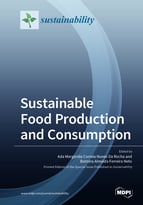Sustainable Food Production and Consumption
A special issue of Sustainability (ISSN 2071-1050). This special issue belongs to the section "Sustainable Engineering and Science".
Deadline for manuscript submissions: closed (31 January 2022) | Viewed by 105732
Special Issue Editors
Interests: food service; catering; food waste; food processing; menu planning; menu sustainability
Special Issues, Collections and Topics in MDPI journals
Special Issue Information
Dear Colleagues,
According to the Food and Agriculture Organization of the United Nations, one-third of world food produced for human consumption is lost or discarded. At the same time, the world needs to create a sustainable food future to feed the more than 9 billion people that are expected to inhabit the planet by 2050. The United Nations’ Sustainable Development Goals represent a global agenda for improving sustainability at a global level, with one of these goals (goal 12) being devoted to ensuring sustainable production and consumption patterns.
This Special Issue intends to be the union of multidisciplinary areas of knowledge, under the sustainability pillar, based on knowledge about one of the most relevant agents for overall environmental impacts: food production and consumption.
Therefore, the aim of this Special Issue is to highlight sustainability assessment within agri-food production, food consumption, and food waste reduction to meet the needs of updating knowledge and developing new skills required by multiple social and economic agents. Food waste implies significant economic losses, ethical and social issues, adverse environmental effects, and considerable nutritional consequences, posing a threat to global sustainability.
The purpose of this Issue is to shine a light on the significance of research and practical initiatives engaged in the United Nations Agenda 2030 for Sustainable Development, specifically in protecting the planet by promoting sustainability in food production and consumption aiming at informing and influencing policy and practice globally.
This Special Issue invites researchers of any discipline that focus on environmental sustainability assessment throughout the supply chain of food production and consumption.
Dr. Ada Margarida Correia Nunes Da Rocha
Dr. Belmira Almeida Ferreira Neto
Guest Editors
Manuscript Submission Information
Manuscripts should be submitted online at www.mdpi.com by registering and logging in to this website. Once you are registered, click here to go to the submission form. Manuscripts can be submitted until the deadline. All submissions that pass pre-check are peer-reviewed. Accepted papers will be published continuously in the journal (as soon as accepted) and will be listed together on the special issue website. Research articles, review articles as well as short communications are invited. For planned papers, a title and short abstract (about 100 words) can be sent to the Editorial Office for announcement on this website.
Submitted manuscripts should not have been published previously, nor be under consideration for publication elsewhere (except conference proceedings papers). All manuscripts are thoroughly refereed through a single-blind peer-review process. A guide for authors and other relevant information for submission of manuscripts is available on the Instructions for Authors page. Sustainability is an international peer-reviewed open access semimonthly journal published by MDPI.
Please visit the Instructions for Authors page before submitting a manuscript. The Article Processing Charge (APC) for publication in this open access journal is 2400 CHF (Swiss Francs). Submitted papers should be well formatted and use good English. Authors may use MDPI's English editing service prior to publication or during author revisions.
Keywords
- sustainability
- environmental impact
- sustainable menus
- sustainable diets
- food waste







